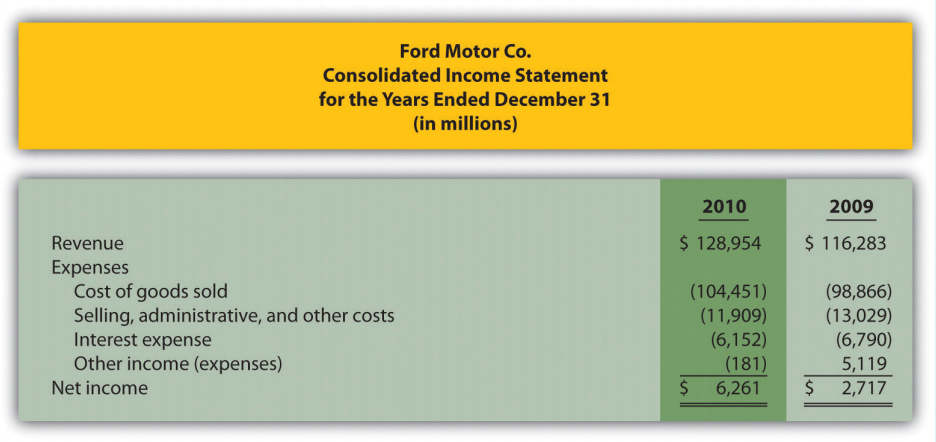10 2. Exercises (Part 1)
Questions
- Describe the characteristics of managerial accounting and financial accounting.
- What are nonfinancial measures of performance? Provide several examples.
- Which accountant (financial or managerial) would prepare each of the following reports:
- Income statement for the Chevrolet division of General Motors
- Balance sheet for PepsiCo prepared in accordance with U.S. GAAP
- The Boston Symphony Orchestra’s budgeted income statement for next quarter
- Defect rate of computer chips produced by Intel
-
Statement of cash flows for Hewlett-Packard prepared in accordance with U.S. GAAP
- Describe the planning and control functions performed by most managers.
- What is the controller’s primary responsibility?
- How do the treasurer’s responsibilities differ from those of the controller?
- Explain why ethical behavior is so important for finance and accounting personnel.
- Briefly summarize the Institute of Management Accountants (IMA) Statement of Ethical Professional Practice shown in Figure 1.2. What is the purpose of this statement?
- Review “Business in Action 2.3”, section 2.5. Why would the company’s former employees improperly record information as described here?
- Review “Business in Action 2.4”, section 2.5. Why is improving ethics a top priority for businesses, such as Home Depot and Hewlett-Packard?
- What is an enterprise resource planning system?
- Why do manufacturing companies use product costing systems to track costs throughout the production process?
- Describe manufacturing costs and nonmanufacturing costs. Provide examples of each.
- Describe the difference between direct materials and direct labor versus indirect materials and indirect labor.
- Why are the terms product costs and period costs used to describe manufacturing costs and nonmanufacturing costs?
- How does the timing of recording expenses differ between product and period costs?
- Review “Business in Action 2.5”, section 2.7. Why are items such as the hull, engine, transmission, carpet, and seats classified as direct materials and items such as glue, paint, and screws classified as indirect materials?
- Review “Business in Action 2.6”, section 2.7. Provide two examples of selling costs and two examples of general and administrative costs at PepsiCo.
- Describe the three inventory accounts used to record product costs.
- What are the three categories of product costs that flow through the work-in-process inventory account? Describe each one.
- When is the cost of goods sold account (often called cost of sales) used, and how is the dollar amount recorded in this account determined?
- Review “Business in Action 2.7”, section 2.8. What are the names and dollar amounts of the inventory accounts appearing on the balance sheet? What is the total amount of
product costs recorded as an expense on the income statement for the year ended December 31, 2010?
- Describe the inventory cost flow equation and how it applies to the three schedules shown in Figure 2.7, section 2.9.
- How does a merchandising company income statement differ from a manufacturing company income statement?
Brief Exercises
- Accounting Information at Sportswear Company. Refer to the dialogue between the president and accountant at Sportswear Company presented at the beginning of the chapter. Why can’t the president find information for each product line(hats and jerseys) in the financial statements? Who within the company typically provides this type of information?
- Financial Versus
Managerial Accounting. Maria is the loan officer at a local bank that lends money to Old Town Market, a small grocery store. She requests several quarterly financial reports on an ongoing basis to assess the store’s ability to repay the loan. Provide one example of a financial accounting report and two examples of managerial accounting reports that Maria might request.
- Planning and Control. Two college graduates recently started a Web page design firm. The first month was just completed, and the owners are in the process of comparing budgeted revenues and expenses with actual revenues and expenses for the month. Would this be considered part of the planning function or the control function? Explain.
- Finance and Accounting Personnel. Determine whether the chief financial officer, controller,treasurer, internal auditor, managerial accountant, financial accountant, or tax accountant would perform the following tasks. (Hint: Some job titles may be used more than once, and others may not be used at all.)
- Prepares annual reports for shareholders and creditors
- Provides a quarterly summary of financial results to the CEO and board of directors
- Provides profit and loss reports by product line
- Calculates estimated quarterly tax payments
- Oversees the treasurer and internal auditor
- Obtains sources of financing and manages short-term investments
- Verifies that annual report financial information is accurate.
-
Enterprise Resource Planning (ERP) System. Enterprise resource planning (ERP)systems are designed to record and share information across functional and geographical areas on a real-time basis. However, these systems tend to be costly to purchase and maintain. Why do organizations continue to invest millions of dollars in ERP systems in spite of the cost?
- Manufacturing Cost Terms. Indicate whether each of the following costs associated with production would be classified as direct materials, direct labor, or manufacturing overhead.
- Salaried supervisor responsible for several product lines
- Hourly workers assembling goods
- Grease used to maintain machines
- Maintenance personnel
- Bike frame used to build a racing bike
- Factory property taxes
- Glue used to assemble toys
- Manufacturing Cost Terms. Indicate whether each of the following costs associated with production would be classified as direct materials, direct labor, or manufacturing overhead.
- Depreciation on production equipment
- Paint used to produce wagons
- Accounting staff performing tax services for a client
- Nails used to assemble cabinets
- Fiberglass used to produce a custom boat
- Hourly workers assembling goods
- Factory utilities
- Manufacturing and Nonmanufacturing Cost Terms. Burns Company incurred costs for the following items.
- Salary of chief financial officer
- Factory insurance
- Salary for salespeople
- Raw materials used in production easily traced to the product
- Computer equipment depreciation for accounting department
- Insurance for headquarters building
- Production line workers
- Clerical support for production supervisors
Required:
- Indicate whether each item should be categorized as a product or period cost.
- Indicate whether each item should be categorized as direct materials, direct labor,manufacturing overhead, selling, or general and administrative.
- Manufacturing and Nonmanufacturing Cost Terms. Leighton, Inc., incurred costs for the following items.
- Janitorial services in the production facility
- Personnel department supplies
- Shipping costs for raw materials purchased from a supplier, easily traced to the product
- Newspaper advertisements
- Supervisor of several production lines
- Insurance for factory equipment
- Production line workers
- Clerical support for sales staff
Required:
- Indicate whether each item should be categorized as a product or period cost.
- Indicate whether each item should be categorized as direct materials, direct labor,manufacturing overhead, selling, or general and administrative.
- Accounts Used to Record Product Costs. Match each of the following accounts with the appropriate description that follows.
| _____ Raw materials inventory | 1. Used to record product costs associated with goods that are sold |
| _____ Work-in-process inventory | 2. Used to record the cost of materials not yet put into production |
| _____ Finished goods inventory | 3. Used to record product costs associated with goods that are complete and ready to sell |
| _____ Cost of goods sold | 4. Used to record product cost associated with incomplete goods in the production process associated with incomplete goods in the production process. |
- Income Statement Terminology: Manufacturing Versus Merchandising. Match each of the following terms used in a manufacturing company’s income statement with the equivalent term used in a merchandising company’s income statement.
| Manufacturing Company | Merchandising Company |
| _____ Cost of goods manufactured | 1. Merchandise inventory |
| _____ Work-in-process inventory | 2. Same term is used by a merchandising company |
| _____ Finished goods inventory | 3. Net purchases |
| _____ Cost of goods sold | 4. Not applicable for a merchandising company. |
Exercises: Set A
- Financial Versus Managerial Accounting (Manufacturing). The income statement from Ford’s annual report appears as follows in summary form. (This information was obtained from the company’s Web site, www.ford.com.)

Required:
- The financial information in the company’s annual report was prepared primarily for shareholders and creditors in accordance with U.S. Generally Accepted Accounting Principles (U.S. GAAP). Does the income statement provide enough detailed information for managers at Ford? Explain.
- Provide at least three additional detailed pieces of financial information that would help managers evaluate performance at Ford.
- Provide at least two nonfinancial measures that would help managers evaluate performance at Ford.
- Organizational Structure. The following list of personnel within organizations comes from Figure 2.4, section 2.4.
- Board of directors
- Chief financial officer
-
Controller
- Managerial accountant
- Financial accountant
-
Tax accountant
-
Treasurer
-
Internal auditor
Required:
Match each previous item with the most accurate description as follows.
- Assists in preparing information used for decision making within the organization
- Assists in preparing tax reports for governmental agencies, including the Internal Revenue Service
- Responsible for confirming that controls within the company are effective in ensuring accurate financial data, and serves as an independent link with the board of directors
- Responsible for all finance and accounting functions within the organization and typically reports to the chief executive officer
- Elected by the shareholders of the company
- Oversees the managerial accountant, financial accountant, and tax accountant
- Responsible for obtaining financing for the organization, projecting cash flow needs, and managing cash and short-term investments
- Assists in preparing financial information, usually in accordance with U.S. GAAP, for those outside the company
- Schedule of Raw Materials Placed in Production. The balance in Sedona Company’s raw materials inventory account was $110,000 at the beginning of September and $135,000 at the end of September. Raw materials purchased during the month totaled $50,000. Sedona used $8,000 in indirect materials for the month.
Required:
Prepare a schedule of raw materials placed in production for the month of September.
- Schedule of Cost of Goods Manufactured. The balance in Reid Company’s work-in-process inventory account was $300,000 at the beginning of March and $320,000 at the end of March. Manufacturing costs for the month follow.
|
Direct materials (from the schedule of raw materials placed in production)
|
$ 40,000 |
|
Direct labor
|
$ 70,000 |
|
Manufacturing overhead
|
$200,000 |
Required:
Prepare a schedule of cost of goods manufactured for the month of March.
- Schedule of Cost of Goods Sold. The balance in Blue Oak Company’s finished goods inventory account was $25,000 at the beginning of September and $28,000 at the end of September. Cost of goods manufactured for the month totaled $17,000.
Required:
Prepare a schedule of cost of goods sold for the month of September.
- Income Statement. Auto Products, Inc., had the following activity for the month of October.
| Sales revenue | $1,100,000 |
| Selling expenses | $ 300,000 |
| General and administrative expenses | $ 230,000 |
|
Cost of goods sold
|
$ 475,000 |
Required: Prepare an income statement for the month of October.


